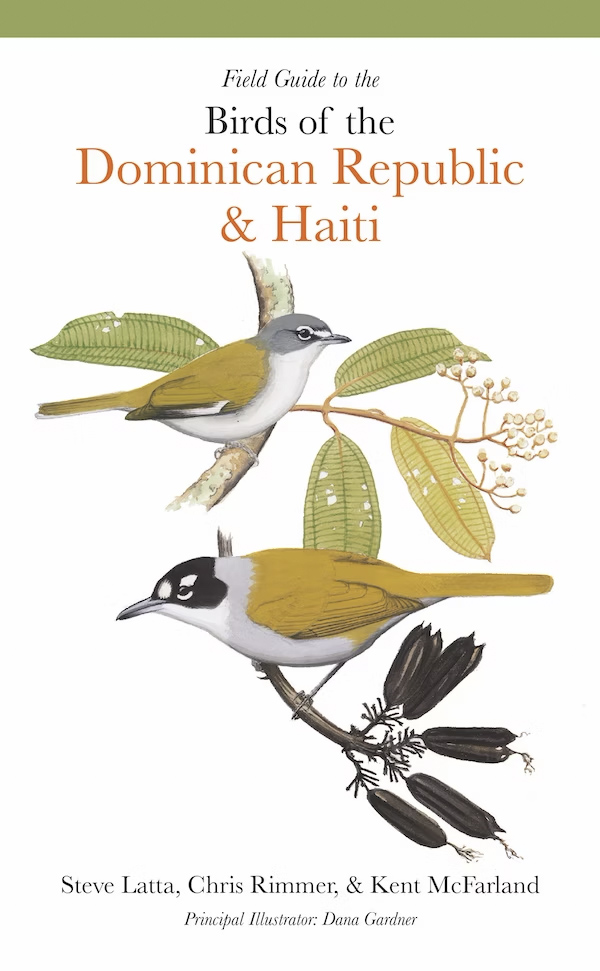Field Guide to the Birds of the Dominican Republic and Haiti. Steven Latta, Christopher Rimmer, and Kent McFarland. 2022. Princeton University Press, Princeton, NJ, USA. 240 pages. ISBN 9780691232393. Paperback ($24.95).

Hispaniola, the second largest island in the West Indies, provides habitat to 318 species of resident and migratory birds. This high species richness is related to the island’s diverse ecosystems and a complex geological history resulting from the merging of different land masses approximately 9 million years ago, as well as climatic changes in the Pleistocene that facilitated speciation. These events played a role in the evolution of 34 endemic species including six endemic genera, Calyptophilus, Microligea, Nesoctites, Phaenicophilus, Xenoligea, and Dulus (the only representative of its family). This is the highest number of endemic species for any Caribbean island.
These restricted-range species rely on the island’s native pine, broadleaf, or dry forests, and thus are affected by habitat loss, degradation, and fragmentation caused by the expansion of agricultural practices and cattle ranching. Also, bird species are increasingly challenged by uncontrolled hunting, the illegal capture of birds for the pet trade, problems with invasive species, and the increasing dangers of climate change. At present, half of the endemic species are considered threatened with extinction.
The Field Guide to the Birds of the Dominican Republic and Haiti published by Steven Latta, Chris Rimmer, and Kent McFarland (2022) represents a new tool for bird identification and provides valuable background information about the habitats and most important birding sites. Introductory sections are noteworthy for summarizing the actions taken by the governments and civil society in the development of environmental education campaigns, and systems for land protection and species-based conservation.
For almost three decades, the authors have engaged in scientific work in these two countries and other Caribbean islands, in collaboration with local colleagues and partners, like the international organization BirdsCaribbean. Their familiarity with the region comes from Latta’s more than 25 years of research initiated as a graduate student working in the Sierra de Bahoruco, and Rimmer’s and McFarland’s studies and protection efforts of the Bicknell’s Thrush (Catharus bicknelli) and Black-backed Petrel (Pterodroma hasitata).
The field guide is an abbreviated and updated version of the comprehensive Birds of the Dominican Republic and Haiti (2006), co-authored along with renowned ornithologists and bird experts Allan Keith, James Wiley, Herbert Raffaele, and Eladio Fernández. This publication was the first guide devoted to the ecology and natural history of Hispaniola’s birds. It was translated into Spanish and French to facilitate its local use.
The current reference focuses on describing field marks to aid in bird identification while presenting changes in taxonomy, and new knowledge on the status, distribution, and habitat use of more than 300 species. Accurate range maps are presented, thanks to the authors’ close involvement with local biologists, birdwatchers, photographers, and ecotourism guides, in addition to valuable records now available through eBird. The list of sponsoring organizations shows a vast collaboration network, while also reflecting a growing local enthusiasm toward the island’s avifauna.
Accompanying color plates present the birds with remarkable detail, match the precise descriptions of plumage key characteristics, size, and behavior, and allow the reader to differentiate among similar species. These beautiful illustrations were produced by Dana Gardner, Tracy Pedersen, Kristin Williams, Barry Kent MacKay, Bart Rulon, and Cynthia Fisher. A separate list of the endemic species and three appendices, summarizing the common names in different languages, the distribution of species throughout offshore islands, and a checklist, are helpful for the guide users. In summary, the guide is a great resource for visitors to one of the top birding destinations in the Caribbean; however, it is mainly intended to instill pride and continue increasing awareness of this unique avifauna among Dominican and Haitian students, researchers, wildlife managers, conservationists, and the general public.
Adrianne G. Tossas
President of BirdsCaribbean
Professor, Department of Natural Sciences
University of Puerto Rico, Aguadilla
Literature Cited:
- Latta, S., C. Rimmer, A. Keith, J. Wiley, H. Raffaele, K. McFarland, and E. Fernández. 2006. Birds of the Dominican Republic and Haiti. Princeton University Press. 258 pp.
Header photo: Caribbean Roseate Tern (Sterna dougalli dougalli), Aleides Morales/USFWS
Suggested citation:
Tossas, A. Review of the book Field Guide to the Birds of the Dominican Republic and Haiti by Steven Latta, Christopher Rimmer, and Kent McFarland. Association of Field Ornithologists Book Review. https://afonet.org/2023/04/field-guide-to-the-birds-of-the-dominican-republic-and-haiti/.
If you are interested in contributing a book review, or if there is a book you would like to see reviewed on our site, you can contact our Book Review Editor, Evan Jackson at evan.jackson@maine.edu
